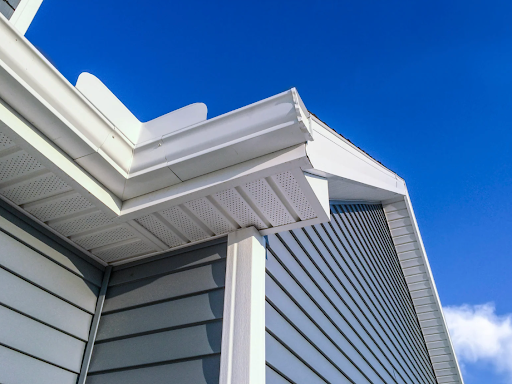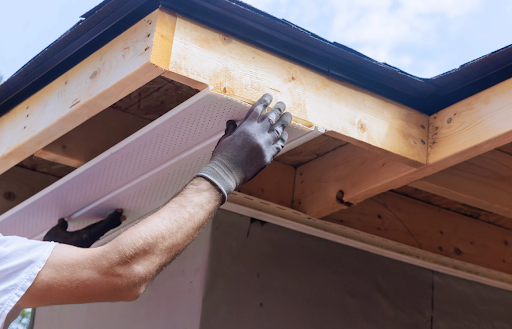What Is a Soffit?

If you’re researching roof maintenance, ventilation, or replacement, you’ve probably heard the term “soffit.” But what is a soffit? And why does it matter for your home in Florida?
A soffit is the finished surface beneath the roof’s overhang. It bridges the gap between your home’s exterior wall and the edge of the roofline. While it may seem like a small detail, the roof soffit plays a major role in protecting your home from moisture, pests, and structural damage, especially in Florida’s hot, humid, and storm-prone environment. In fact, without properly functioning soffits, your attic and roofline could suffer from poor ventilation, mold, and even premature roof failure.
In this article, we’ll break down what a soffit is, the different types, its purpose, common materials, maintenance tips, and signs it might need repair or replacement.
Why Is a Soffit Important?
The soffit does more than just give your home a clean, finished look. It plays a critical functional role in both ventilation and moisture control.
Soffits typically contain small vents or perforations that allow air to circulate into the attic. This airflow is essential for regulating attic temperatures and reducing humidity, which helps prevent mold, mildew, and roof rot. In Florida’s climate, where moisture and heat can be relentless, soffit ventilation is especially important.
Additionally, the soffit protects your rafters and roof decking from rain, wind-driven moisture, and animals like birds or squirrels that may try to nest under your eaves.
What Is a Soffit on a House?
To put it simply, the soffit is the “underbelly” of your roof’s overhang. You’ll see it when you stand next to your house and look up under the edges of the roof. It runs horizontally from the exterior wall to the edge of the fascia board (the front-facing board along the roofline). In most homes, the soffit blends seamlessly with the siding or trim, but it’s a separate, vital component of the overall roofing system.
When paired with ridge vents or gable vents, soffits allow continuous airflow through the attic, which improves energy efficiency and extends the life of your roofing system.
Types of Soffits
Just like roofs, soffits come in a variety of styles and materials, depending on the home’s design and climate needs. Here are the most common types:
1. Vented Soffits
These are the most popular and functional types, especially in hot climates like Florida. Vented soffits have small holes or slots that allow air to flow into the attic space, creating a balanced ventilation system when paired with roof vents.
2. Solid (Non-Vented) Soffits
These are primarily used in decorative applications or in areas where ventilation isn’t needed, such as on gable ends or enclosed porches. While they offer a clean look, solid soffits should be used strategically to avoid limiting airflow to the attic.
3. Continuous Soffit Vents
Instead of individual panels, this type uses a long strip of venting material that runs the entire length of the eave. It provides even, consistent airflow and is ideal for larger homes or roofs with extended overhangs.
Common Soffit Materials
Soffits need to be durable enough to handle outdoor exposure and moisture without deteriorating. Here are the materials most commonly used:
1. Vinyl Soffit
Vinyl is one of the most popular materials thanks to its affordability, durability, and ease of installation. It’s water-resistant, won’t rot, and is available in vented or solid designs. It also comes in a variety of colors to match or complement your home’s exterior.
2. Aluminum Soffit
Aluminum is another low-maintenance option. It’s resistant to rust, lightweight, and offers excellent ventilation properties. It performs well in humid climates and is often used in homes near the coast.
3. Wood Soffit
Traditional and warm in appearance, wood soffits are typically found in older or high-end homes. However, they require regular sealing or painting to resist rot and insect damage, especially in Florida’s wet climate.
4. Fiber Cement Soffit
This material combines cement, sand, and cellulose fibers to create a very strong, weather-resistant surface. Fiber cement soffits mimic the appearance of wood but last much longer with less maintenance.
5. Steel Soffit
Though less common in residential homes, steel soffits offer unmatched durability and fire resistance. They’re ideal for homeowners who prioritize strength and longevity, although they tend to be more expensive.
What Happens If You Don’t Have a Soffit?
Without a functioning soffit, your attic lacks proper ventilation, which can trap heat and humidity under the roof. Over time, this excess moisture can cause mold, sagging insulation, wood rot, and deterioration of roofing materials. You may also see spikes in energy bills, as hot air builds up in your attic and affects your home’s temperature regulation.
Beyond ventilation, soffits also keep out pests. A missing or damaged soffit creates easy access points for birds, rodents, and insects to enter your roof cavity or attic.
Signs Your Soffit Needs Repair or Replacement

Your soffit may not be something you look at every day, but when it fails, your home can suffer. Here are a few red flags to watch out for:
- Visible cracks, peeling paint, or sagging panels
- Soft or spongy wood when touched (for wood soffits)
- Signs of animal nesting or pest activity near eaves
- Water stains on exterior walls or ceilings inside the home
- Increased attic humidity or mold growth
Routine roof inspections can catch these problems early. At King Roofing, we inspect the entire roofing system, including the soffits, during every free consultation.
Soffit Maintenance Tips for Florida Homes
Maintaining your roof soffit is relatively simple, but regular care helps prevent long-term damage:
- Clean vents annually to prevent dust or insect blockages.
- Look for rust or corrosion on metal soffits and repaint or replace as needed.
- Seal any cracks in wood soffits to prevent water infiltration.
- Trim nearby tree branches to reduce the risk of damage from falling limbs.
- Check for moisture buildup in the attic, which may indicate poor airflow.
Soffits and the Florida Building Code
In Florida, proper roof ventilation isn’t just good practice, it’s part of building code compliance. Soffits are often required to help maintain balanced airflow and prevent moisture damage in enclosed attic spaces. If you’re replacing your roof or undergoing a remodel, it’s important to make sure your soffits meet current code standards.
At King Roofing, we ensure that every soffit we install or repair complies with Florida’s strict codes and is designed to maximize your home’s protection and efficiency.
When to Call a Roofing Professional
While soffit repair might seem like a DIY project, professional installation ensures proper ventilation, weather sealing, and code compliance. If you’re noticing signs of soffit damage or you’re not sure what condition your soffit is in, it’s time to schedule a free inspection.
King Roofing has been serving Naples and Southwest Florida for over 45 years. Our experienced team understands how soffits work within the entire roofing system, and we’ll assess whether you need a simple repair or a full replacement.
Get a Free Roof Inspection from King Roofing Today!
Now that you know what a soffit is and why it matters, the next step is making sure yours is doing its job. Whether you’re dealing with visible damage, poor ventilation, or you’re unsure when your soffit was last checked, King Roofing is here to help.
We’ve been serving Naples and the Southwest Florida region since 1979 with honest service, high-quality workmanship, and complete roofing system expertise. Every new installation comes with a 5-year transferable workmanship warranty, and our team is fully licensed and insured.
Call us today to schedule your free roof inspection or use our instant roof quote tool to get started online in minutes. Trust the team that’s been protecting Florida homes for over four decades.
Frequently Asked Questions
Q: What is a soffit?
A: A soffit is the exposed underside of a roof’s overhang. It connects the edge of the roof to the home’s exterior wall and typically contains vents to promote attic airflow. Soffits play a key role in regulating temperature and moisture inside the attic, which helps preserve the integrity of your roofing system.
Q: What is a soffit on a house used for?
A: Soffits serve two main purposes: improving attic ventilation and protecting the roof structure from moisture, pests, and weather damage. They also give your roofline a clean, finished look. In warm, humid regions like Florida, soffits are especially important for preventing mold and prolonging the life of your roof.
Q: Does every home need a soffit?
A: While not every architectural style includes soffits, most modern homes benefit from having them, especially in hot or humid climates like Florida, where airflow and moisture control are critical. Without proper ventilation, attic spaces can become hot and damp, leading to mold growth and wood rot.
Q: How long does a soffit last?
A: It depends on the material. Vinyl or aluminum soffits can last 20 to 30 years with minimal maintenance and regular cleaning. Wood soffits may require more frequent care or replacement depending on exposure to rain, humidity, and pests. Regular inspections help catch early signs of deterioration.
Q: Can soffits be repaired, or do they need to be replaced?
A: Minor cracks or isolated damage can often be repaired with caulking, paint, or panel replacement. However, widespread rot, mold, sagging, or pest infestation may require a full soffit replacement to restore proper ventilation and protect the structure of your home from further damage.












